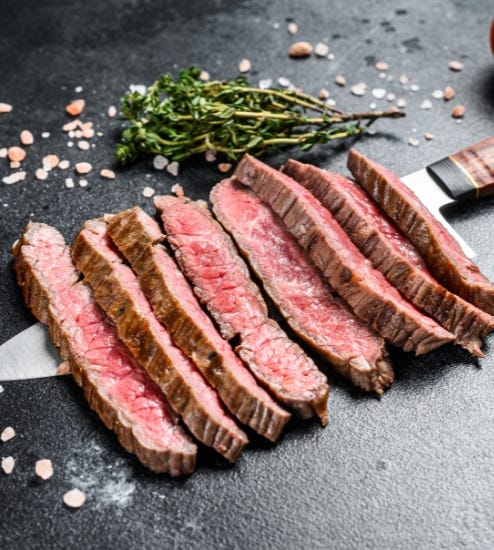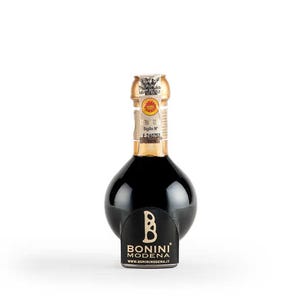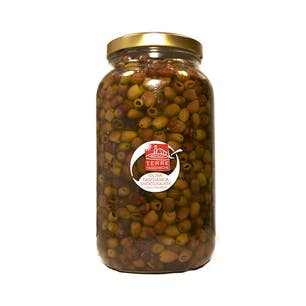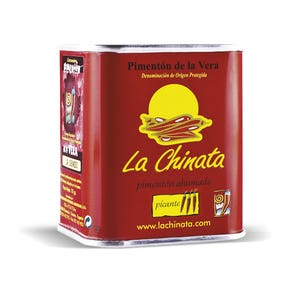Striploin
BEEF CUTS
Discovering Striploin
Whether you want to call it Roastbeef, Entrecote or Striploin, the substance does not change. It is one of the great classic cuts of French butchery, the fattest part of the beef taken from the area between the two ribs in the sirloin. Precisely because it is made from a muscle little used by the animal, roast beef is very tender and rich in flavor. This makes it one of the most valued and delicious beef cuts.
The French word Entrecote is used internationally to refer to beef steaks, usually boneless. Entrecote is a cut of meat characterized by heavy marbling, the infiltration of fat within the animal's muscle fibers. The more marbled the striploin, the richer in flavor and more tender it will be. In addition, roast beef has a typical strip of fat around it.


How to cook striploin
Before moving on to cooking the striploin, it is recommended to take the meat out of the fridge and let it rest at room temperature for at least an hour. This process will avoid the violent temperature changes that would cause the meat fibers to harden quickly. After drying the meat with paper towels to remove excess moisture, sprinkle it with salt and grease the surface with a drizzle of extra-virgin olive oil: this will make the entrecote crispy on the outside and juicy on the inside.
The striploin can be cooked very easily in a nonstick skillet or on a red-hot grill pan. The most important thing is to choose a quick, high-temperature technique, such as barbecue, grill, or griddle cooking.
Regardless of the cooking method you choose, it is important that the cooking surface be very hot at the time the meat is placed to cook, so as to activate the famous Maillard reaction and give the meat that externally caramelized flavor we so much appreciate. It is essential never to poke holes in the meat during cooking, to avoid letting it lose its delicious juices.
Cooking time in the pan or on the grill will vary according to your preference and the thickness of the slice of meat: count 2-3 minutes per side for a rare steak. If desired, the meat can finish cooking in the oven for 5 minutes in grill mode at 250°.


Our striploin selection


Japanese Wagyu striploin is a perfectly balanced cut of fat and meat with a unique marbling. What distinguishes it is the marbling of the meat: the intramuscular fat, which are more evenly and homogeneously distributed. The presence of this high amount of fat allows the meat to be particularly tasty and tender.
Given the value of this Japanese meat, grilling or barbecuing is asolutely not recommended because the fat would be attacked by the flame and all the juices of the meat would be lost. In Japan, it is common to serve Wagyu beef in thin slices and cook it on a griddle "Teppanyaki," on a cast-iron plate "Sukiyaki," or in a light broth, the famous "Shabu-Shabu."


Piedmontese Fassona Striploin, also known as sirloin, is found along the spine in the hindquarters, running from the ribs to the rump. This is Italian meat of 100% female Fassona breed at least 36 months old. The meat of the females has a natural marbling of fat that makes it tender and tasty, with a rich and rounded aroma, with a perfect balance between sweetness and savoriness, with hints of hazelnuts.
The history of the Piedmontese breed dates back to the Paleolithic period, when wild cattle species merged with zebu herds from Pakistan. The new crossbreeding spread in Italy; excellent for milk and meat, this breed was used as a working animal, a factor that influenced the genetics and eventually generated hypertrophy of the rump and leg muscles.


Rubia Gallega striploin is a tender cut of Spanish meat dry aged for 21 days. This cut does not refer exactly to an anatomical portion, but it may refer to those parts next to the tenderloin, which is almost always the rump, a highly prized cut from the beef. The Rubia Gallega is the most interesting breed of cattle in the Spanish scene, distinguished by its unique aroma.
The Rubia Gallega is a type of Old Cow, a cattle from northwestern Spain. These cows can reach 7 to 10 years of age, grazing freely in the mountains, feeding on grass and grains. Rubia Gallega is one of the finest meats in the world, the name Rubia Gallega comes from the color of the cows and their origin, namely blond and Galician cows.
Longino & Cardenal
Longino & Cardenal stands today as one of Italy's leading "food globetrotters." With passion and courage it carries out a continuous search for the best raw materials, often little known to most, in order to meet the new trends in consumer behavior that seek excellent products proposed in innovative forms. All our deliveries use specialized, refrigerated couriers.













